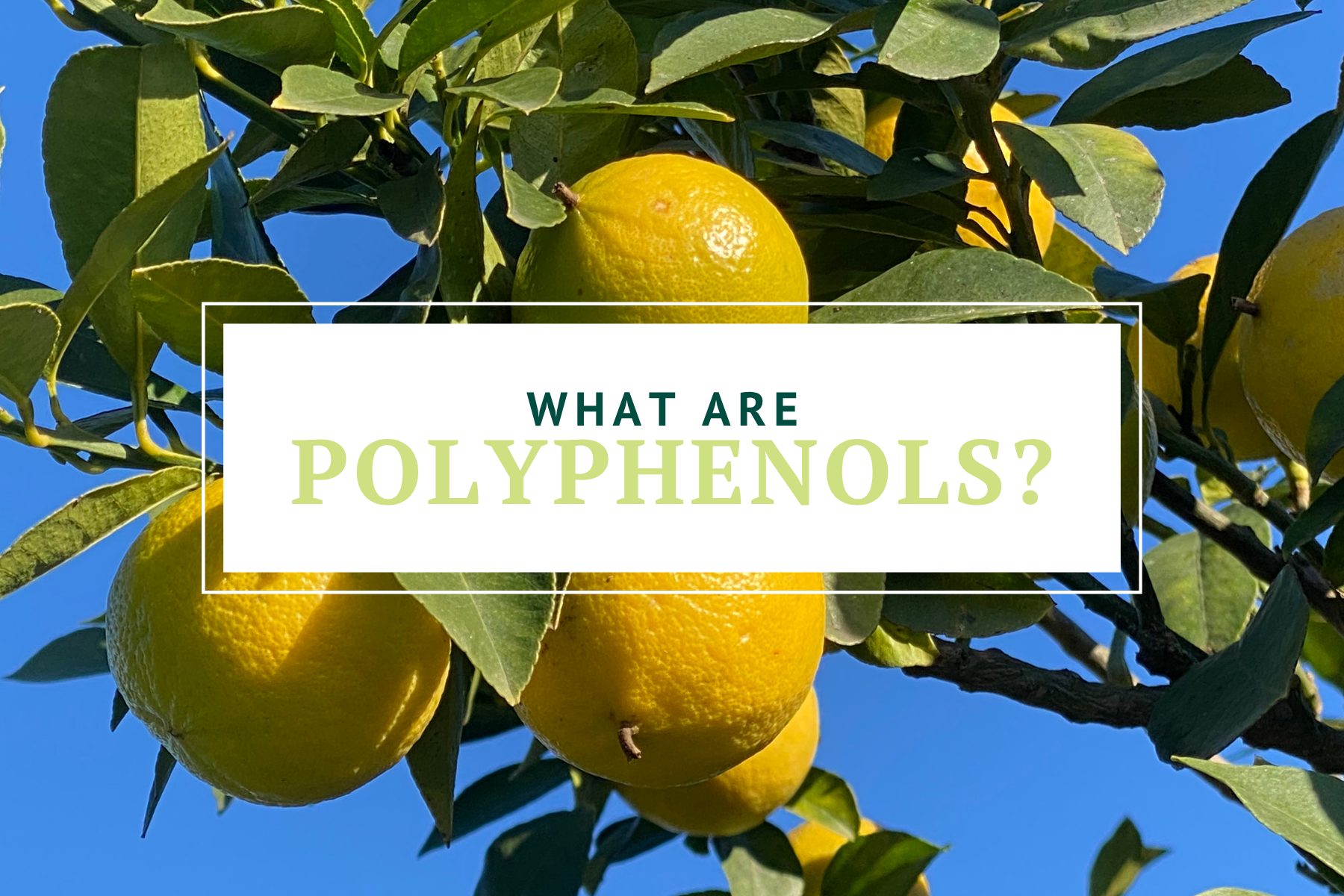Polyphenols are natural compounds plants make for protection. When we eat them, they can help support antioxidant defenses, a healthy inflammatory balance, vascular (endothelial) function, and normal lipid metabolism as part of an overall healthy lifestyle.1, 2
What Are Polyphenols?
Polyphenols are a large family of plant nutrients. Major groups include flavonoids (like those in citrus, apples, and onions), phenolic acids (coffee), stilbenes (resveratrol), and lignans (seeds). The health impact depends on the type, the amount you eat, and how well your body absorbs them (bioavailability).1
How Polyphenols Work
- Antioxidant support: Help neutralize free radicals and up-regulate your body's own defenses (e.g., Nrf2 pathways).2
- Inflammatory balance: Modulate signals like NF-κB that influence normal inflammatory responses.3
- Vascular support: Aid healthy nitric-oxide–mediated vasodilation and endothelial function.4
- Lipid metabolism: Support normal cholesterol handling and lipoprotein balance.4
- Microbiome interactions: Gut microbes transform polyphenols into bioactive metabolites; this two-way relationship contributes to benefits.5
Citrus Bergamot Polyphenols: What's Inside and What They Do
Citrus bergamot (Citrus bergamia) is naturally rich in citrus flavanones and unique compounds. Repeated analyses identify high levels of:
- Neoeriocitrin, neohesperidin, and naringin — abundant flavanones that contribute antioxidant activity and support healthy inflammatory and endothelial responses.6, 4
- Brutieridin and melitidin — uncommon citrus constituents with an HMG-like side chain. In vitro and cell data suggest they interact with cholesterol pathways (e.g., HMG-CoA reductase binding; intestinal cholesterol uptake proteins), supporting normal cholesterol metabolism.7, 8
What Human Studies Report (Structure/Function Summary)
Clinical investigations using bergamot juice or standardized bergamot polyphenolic fraction (BPF) report support for a healthy lipid profile when combined with diet and lifestyle:
- Overview of evidence: Recent reviews summarize trials where bergamot preparations supported favorable lipid parameters and oxidative balance.9
- Randomized controlled trials:
These findings support normal physiology (antioxidant status, lipid metabolism, endothelial function). They do not diagnose, treat, cure, or prevent disease.
Top 10 Dietary Sources of Polyphenols
Rotate a variety of these foods each week to increase your polyphenol diversity:1, 12
- Berries (blueberries, strawberries)
- Citrus (oranges, grapefruit, bergamot in teas or standardized extracts)
- Apples and onions
- Cocoa/dark chocolate
- Green and black tea
- Coffee
- Olives and extra-virgin olive oil
- Grapes and red wine (if you drink alcohol, do so in moderation)
- Herbs and spices (oregano, turmeric)
- Nuts and seeds
Practical Tips
- Use a "eat the rainbow" approach: different colors often mean different polyphenol families.1
- Pair with whole-food fats (e.g., olive oil) to support absorption of certain compounds.1
- For supplements, choose products with standardized polyphenol content and transparent third-party testing. Bergamot studies typically use standardized extracts of the polyphenolic fraction.9
Key Takeaways
- Polyphenols help support antioxidant defenses, vascular health, inflammatory balance, and normal lipid metabolism.2, 4
- Citrus bergamot is rich in neoeriocitrin, neohesperidin, naringin, and unique brutieridin/melitidin studied for roles in cholesterol metabolism support.7, 6
- Human studies of bergamot preparations report supportive effects on lipid profiles alongside diet and lifestyle; results vary by product and dose.9, 10,
Build your weekly plan around the 10 food sources above. If you explore citrus bergamot, look for a standardized extract with clear labeling of key polyphenols and third-party testing.
References
- Manach C, Scalbert A, Morand C, Rémésy C, Jiménez L. Polyphenols: food sources and bioavailability. Am J Clin Nutr. 2004;79(5):727-747. PMID: 15113710.
- Hussain T, Tan B, Yin Y, et al. Oxidative Stress and Inflammation: The Polyphenols' Role. Oxid Med Cell Longev. 2016;2016:7432797. PMID: 27051417.
- Rahman I, Biswas SK, Kirkham PA. Regulation of inflammation by dietary polyphenols. Biochem Pharmacol. 2006;72(11):1439-1452. PMID: 16973385.
- Ciumărnean L, Milaciu MV, Runcan O, et al. The effects of flavonoids on cardiovascular health. Nutrients. 2020;12(6):1690. PMID: 32570958.
- Cardona F, Andrés-Lacueva C, Tulipani S, Tinahones FJ, Queipo-Ortuño MI. Interactions of polyphenols with gut microbiota. J Agric Food Chem. 2013;61(40):9517-9533. PMID: 24066792.
- Ferlazzo, N., Visalli, G., Cirmi, S., & Calapai, G., et al. (2016). Bergamot (Citrus bergamia Risso) juice extract attenuates lipopolysaccharide-induced inflammatory response through inhibition of NF-κB pathway in THP-1 monocytes. PLoS ONE, 11(5), e0155999.
- Di Donna L, De Luca G, Mazzotti F, et al. Statin-like principles of bergamot fruit: isolation of brutieridin and melitidin. J Nat Prod. 2009;72(7):1352-1354. PMID: 19518074.
- Parafati, M., Lascala, A., Morittu, V. M., Trimboli, F., Rizzuto, A., Brunelli, E., ... & Mollace, V. (2015). Bergamot polyphenols boost therapeutic effects of low rosuvastatin doses in hyperlipidemic rats: Effects on lipid metabolism and oxidative stress. PLoS ONE, 10(12), e0143390.
- Lamiquiz-Moneo I. et al., “Effect of bergamot on lipid profile in humans.” Crit Rev Food Sci Nutr 2020;60(18):3133-3143. doi:10.1080/10408398.2019.1677554.
- Gliozzi M, Walker R, Muscoli S, et al. Bergamot polyphenolic fraction (BPF) enhances rosuvastatin effects. Front Pharmacol. 2013;4:88. PMID: 24062615.
-
Mollace V, Sacco I, Janda E, et al. Hypolipemic and hypoglycaemic activity of bergamot polyphenolic fraction. Fitoterapia. 2011;82(3):309-316. PMID: 21056691.
- Pérez-Jiménez J, Neveu V, Vos F, Scalbert A. Systematic analysis of the polyphenol content of foods (Phenol-Explorer 2.0). Food Chem. 2010;130(4):881-888. PMID: 22130390.
*These statements have not been evaluated by the Food and Drug Administration. This content is for educational purposes only and is not intended to diagnose, treat, cure, or prevent any disease. Always speak with your healthcare provider before starting any new supplement, especially if you take medications or have a medical condition.*



